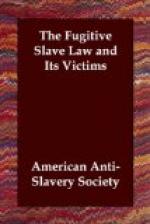the claimant of an alleged fugitive, at night, knocked
at the door of a colored family, and asked for a light
to enable them to mend their broken harness. The
door being opened for this purpose, the marshal’s
party rushed in, and said they came to arrest
a fugitive slave. Resistance was made by
the occupant of the house and others, and the marshal’s
party finally driven off—the slave owner
advising that course, and saying, “Well,
if this is a specimen of the pluck of Pennsylvania
negroes, I don’t want my slaves back.”
The master of the house was severely wounded in
the arm by a pistol shot; still he maintained
his ground, declaring the marshal’s party
should not pass except by first taking his life.
Marion, Williamson County, Ill., about December 10, 1850. Mr. O’Havre, of the city police, Memphis, Tennessee, arrested and took back to Memphis a fugitive slave, belonging to Dr. Young. He did so, as the Memphis paper states, only “after much difficulty and heavy expense, being strongly opposed by the Free Soilers and Abolitionists, but was assisted by Mr. W. Allen, member of Congress, and other gentlemen.”
Philadelphia, about January 10, 1851. G.F. Alberti and others seized, under the Fugitive Slave Law, a free colored boy, named JOEL THOMPSON, alleging that he was a slave. The boy was saved.
STEPHEN BENNETT, Columbia, Penn., arrested as the slave of Edward B. Gallup, of Baltimore. Taken before Commissioner Ingraham; thence, by habeas corpus, before Judge Kane. He was saved only by his freedom being purchased by his friends.
The Huntsville (Ala.)
Advocate, of January 1, 1851, said
that Messrs. Markwood
& Chester had brought back “seven of
their Slaves”
from Michigan.
The Memphis (Tenn.) Eagle, of a later date, says that within a few weeks “at least five fugitive slaves have been brought back to this city, from free States, with as little trouble as would be had in recovering stray cows.” The same paper adds, “We occasionally receive letters notifying us that a slave, said to be the property of some one in this vicinity, has been lodged in jail in Illinois or Indiana, for his owner, who will please call, pay charges, and take him away.”
In Boston, end of January, 1851. A colored man, lately from North Carolina, was sought by officers, under Marshal Devens, aided by a lawyer, named Spencer, provided by the New York Union Safety Committee. The arrest was not attempted. It was found that the colored man was too strongly guarded and protected.
Mrs. TAMOR, or EUPHEMIA WILLIAMS, Philadelphia, February, 1851, mother of six children, arrested and brought before Commissioner Ingraham, as the slave Mahala, belonging to William T.J. Purnell, of Worcester County, Maryland, admitted to have been absent since 1829—twenty-two years.




